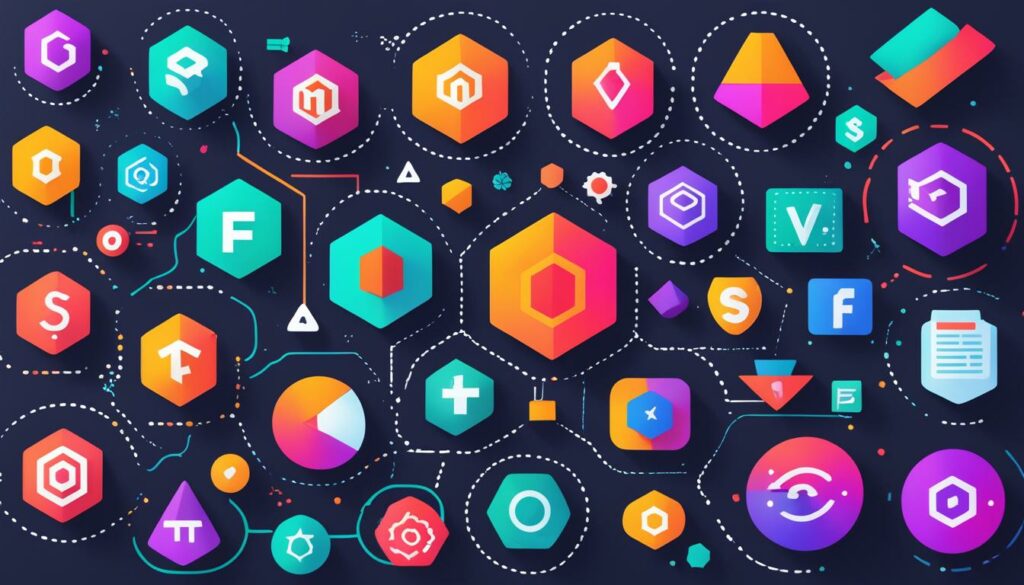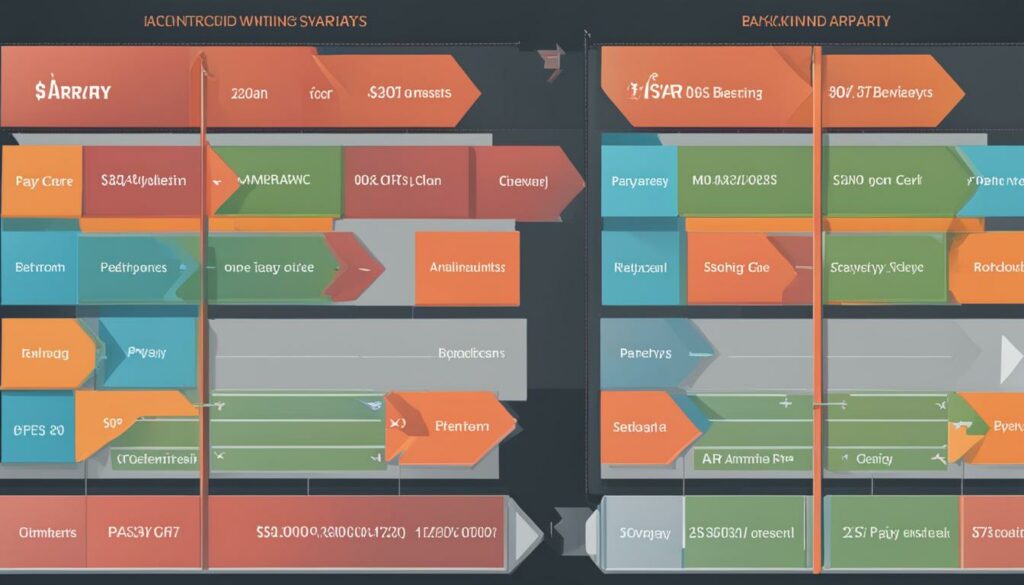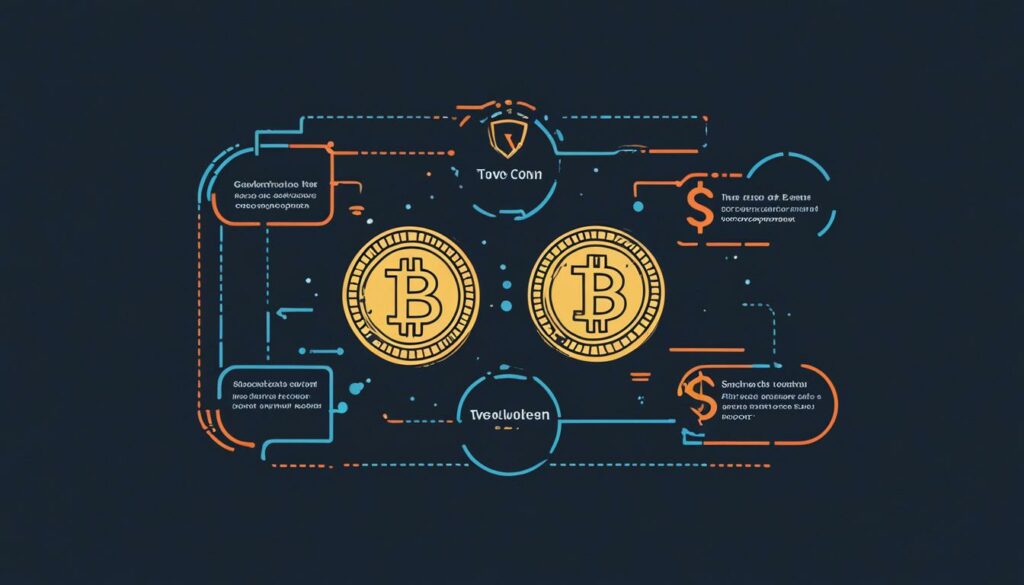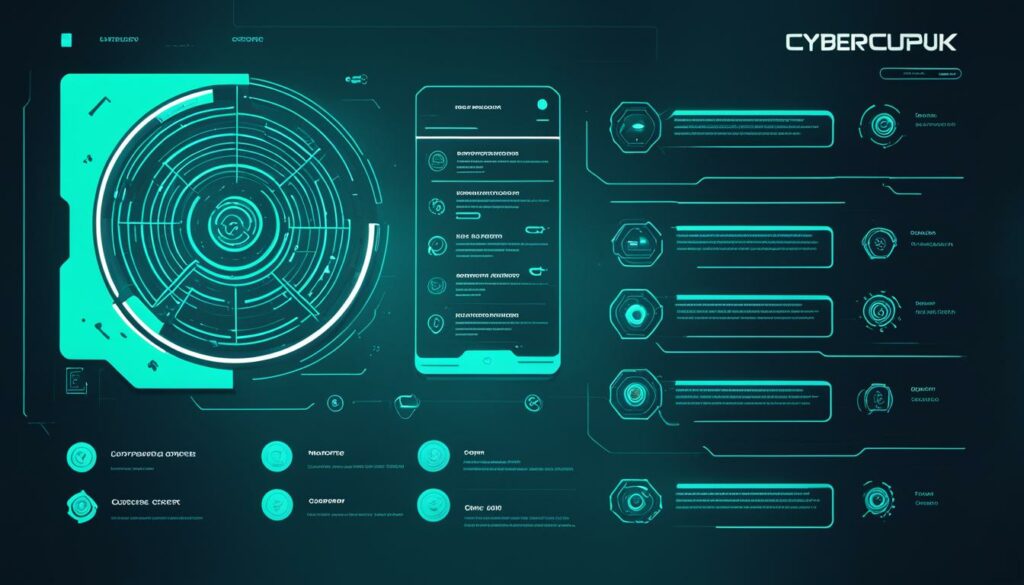Welcome to the world of web development, where two crucial sides come together to create stunning and functional websites. In this article, we’ll explore the differences between frontend and backend development, the skills required for each role, the technologies involved, and the career opportunities they offer.
Frontend development focuses on the user-facing side of a website. It involves designing and building the visual aspects that users interact with, such as the layout, colors, fonts, and navigation menus. Frontend developers use languages like HTML, CSS, and JavaScript to create the user interface and ensure a seamless user experience.
On the other hand, backend development deals with the invisible structure that powers the website. Backend developers work behind the scenes to handle data management, server-client communication, and database management. They use languages like Java, Python, and Ruby to build the logic and functionality of the website.
While frontend developers bring websites to life with their creative designs and user-focused approach, backend developers ensure that everything works smoothly on the server side, providing the necessary database support and processing functionality.
Both frontend and backend development require a strong command of coding skills and an understanding of web development principles. Whether you prefer to focus on the visual side of websites or enjoy diving into the technical aspects, both roles offer exciting opportunities in the ever-evolving field of web development.
Key Takeaways:
- Frontend development focuses on the visual and user-facing side of websites.
- Backend development deals with the server-side functionality and data management.
- Frontend developers work with languages like HTML, CSS, and JavaScript.
- Backend developers use languages like Java, Python, and Ruby.
- Both roles require strong coding skills and offer unique career paths in web development.
Ready to dive deeper into frontend and backend development? Let’s explore each side in more detail and discover the skills, technologies, and job prospects they offer.
What is Frontend Development?
Frontend development is a crucial aspect of website creation that focuses on the part of a website that the user interacts with directly. It involves designing and building the visual elements of a website, such as the layout, colors, fonts, and navigation menus, to deliver an optimal user experience. Frontend developers utilize HTML, CSS, and JavaScript to create the user interface and ensure the website is both responsive and visually appealing.
HTML is the building block that structures the content of the website, while CSS is responsible for styling and making the website visually attractive. JavaScript adds interactivity and enhances user experience with features like interactive forms, dynamic content, and engaging animations.
“Frontend development is like creating the look and feel of a website; it’s all about designing the user experience.”
As a frontend developer, you play a crucial role in building the foundation of a website. By utilizing HTML, CSS, and JavaScript, you have the ability to craft engaging web experiences that captivate users and make them want to explore further.
Building Blocks of the Internet
- HTML: Hypertext Markup Language is the structure of the web. It defines the structure and layout of a webpage, allowing you to organize and present content.
- CSS: Cascading Style Sheets is responsible for the visual appearance of a webpage. It enables you to customize the colors, fonts, and layout to create a visually appealing website.
- JavaScript: JavaScript brings interactivity to a website. It allows you to create dynamic elements, handle user interactions, and add functionality to enhance the user experience.
These three languages are the fundamental building blocks of the internet and the tools you need to master as a frontend developer. Together, they form a powerful toolkit that empowers you to create captivating and user-friendly websites.
Frontend Developer Skills
Frontend development requires a specific set of skills to thrive in this role. As a frontend developer, you need to be proficient in HTML, CSS, and JavaScript. These three languages are the building blocks of frontend development, allowing you to create captivating and interactive websites. Here’s a breakdown of each skill:
HTML (Hypertext Markup Language)
HTML is the foundation of every webpage. It provides the structure and organization of the content. By using HTML tags, you can define headings, paragraphs, links, images, and other elements that make up the structure of a webpage.
CSS (Cascading Style Sheets)
CSS is responsible for the visual styling of a webpage. It allows you to control the layout, colors, fonts, and overall design of the website. With CSS, you can create stunning and responsive webpages that adapt to different screen sizes and devices.
JavaScript
JavaScript adds interactivity and dynamic functionality to a website. It enables you to create animations, handle user input, validate forms, and perform various interactive tasks. JavaScript is also used to integrate third-party libraries and frameworks into your frontend projects.
Aside from technical skills, frontend developers also benefit from strong communication skills. As a frontend developer, you often collaborate with clients, designers, and other members of the development team. Effective communication allows you to understand project requirements, explain design decisions, and contribute to a seamless development process.
Moreover, creativity plays a vital role in frontend development. You need to think creatively to design visually pleasing and user-friendly websites. With a creative mindset, you can explore unique styles, layouts, and interactions that engage users and enhance their browsing experience.
By mastering these frontend developer skills, you can create visually stunning websites that captivate users and deliver an exceptional user experience.

What is Backend Development?
Backend development plays a crucial role in websites, focusing on the server side and ensuring efficient data management, server-client communication, and database operations. While frontend development takes care of the user-facing side, backend development handles the logic and functionality that makes everything work seamlessly on the client side. Backend developers utilize programming languages such as Java, Python, and Ruby to build the backbone of a website.
One of the primary tasks of backend developers is managing databases, which involves storing, organizing, and retrieving data efficiently. They also establish smooth server-client communication, ensuring that requests from the frontend are received and processed correctly by the server. By handling data processing and implementing secure data management techniques, backend developers contribute to the creation of dynamic web applications that can handle user input and deliver personalized experiences.
Backend development is like the powerhouse behind the scenes, ensuring that websites run smoothly and efficiently.
A well-structured backend is essential for websites that handle large volumes of data or require complex functionalities. Backend developers work hand-in-hand with frontend developers to ensure seamless integration between the front and backend systems, resulting in a cohesive and user-friendly website experience.
Interested in backend development? Don’t forget to check out BoostedHost’s WordPress Hosting for optimal performance. Sign up now through this link: www.boostedhost.com/wordpress-hosting.

Backend Developer Skills
Backend developers play a critical role in web development, and to excel in this field, you’ll need a range of skills. Here are the key skills required to be a successful backend developer:
1. Expertise in Programming Languages
Backend developers primarily work with programming languages such as Java, Python, and Ruby. These languages provide the foundation for building robust server-side applications and handling data management tasks.
2. Problem-Solving Skills
As a backend developer, you’ll encounter technical challenges and bugs that need to be resolved. Strong problem-solving skills will help you efficiently debug and fix issues, ensuring the smooth functioning of backend systems.
3. Communication Skills
Collaboration is essential in web development, and backend developers need to communicate effectively with frontend developers, management, and business stakeholders. Clear and concise communication ensures that everyone is on the same page and allows for seamless teamwork.
By combining your expertise in programming languages like Java, Python, or Ruby with problem-solving and communication skills, you’ll be well-equipped to tackle the challenges of backend development.
BoostedHost offers WordPress Hosting for optimal performance. Sign up now here!
Frontend vs Backend Comparison
When it comes to building websites, both frontend and backend development play crucial roles in ensuring a fully functional and visually appealing online presence. Let’s take a closer look at the difference between these two sides of web development.
Frontend Development: Building the User-Facing Side
Frontend development focuses on the visible aspects of a website that users see and interact with. It involves creating the user interface, designing the layout, selecting colors and fonts, and ensuring a smooth user experience. Frontend developers use languages like HTML, CSS, and JavaScript to bring life to the website and make it responsive and visually appealing.
HTML (Hypertext Markup Language) provides structure and organizes the content of a webpage. CSS (Cascading Style Sheets) is responsible for the visual presentation, including colors, fonts, and layout. JavaScript is a programming language that adds interactivity and functionality to the frontend, making elements on the webpage come alive.
Frontend development is all about creating an engaging and user-friendly experience for website visitors. It involves understanding design principles, user behavior, and the best practices for creating an intuitive interface.
Backend Development: Making the Magic Happen
While frontend development focuses on the visible aspects of a website, backend development handles the behind-the-scenes functionality and data management. It involves writing server-side code, managing databases, handling server-client communication, and processing data.
Backend developers use languages like Java, Python, and Ruby to build the logic and structure of a website. They handle tasks such as data storage, retrieval, and manipulation, ensuring the website can handle user input and provide dynamic content.
Backend development is responsible for building the server-side architecture that allows the frontend to function seamlessly. It involves working with databases, APIs, and other technologies to ensure efficient data management and secure server-client interactions.
Different Technical Requirements
Frontend and backend development require different sets of technical skills. Frontend developers need proficiency in HTML, CSS, and JavaScript, along with a keen eye for design and user experience. They focus on creating visually appealing and interactive interfaces that engage users.
On the other hand, backend developers require expertise in programming languages like Java, Python, or Ruby. They need to understand server-side architecture, databases, and server-client communication to ensure the smooth functioning of the website.
Website Functionality: The Frontend and Backend Partnership
Frontend and backend development go hand in hand to create a fully functional website. While frontend development focuses on the visible aspects, backend development handles the behind-the-scenes functionality.

| Frontend Development | Backend Development |
|---|---|
| Focuses on the user-facing side | Handles the behind-the-scenes functionality |
| Creates the visual aspects of the website | Manages data storage, retrieval, and processing |
| Uses HTML, CSS, and JavaScript | Uses languages like Java, Python, or Ruby |
| Ensures an appealing user interface | Handles server-side logic and server-client communication |
Both frontend and backend development require strong coding and problem-solving skills. Frontend developers focus on creating a visually pleasing and intuitive user interface, while backend developers ensure data management and the smooth functioning of the website’s backend.
Ultimately, frontend and backend development are complementary and jointly contribute to the overall functionality and success of a website.
Frontend vs Backend Salaries
When considering a career in web development, one important factor to consider is the salary potential of frontend and backend developers. While salaries can vary depending on factors such as location, experience, and specific skillset, backend developers generally tend to earn higher salaries compared to their frontend counterparts.
According to PayScale data from March 2023, the average salary for a backend developer is $90,652, while the average salary for a frontend developer is $80,796. This difference in income can be attributed to the complexity and technicality of backend development, which often requires advanced programming skills and a deep understanding of server-side systems and data management.
“Backend development involves handling the behind-the-scenes functionality of a website, ensuring server-client communication, and managing databases. These technical skills are highly sought after in the industry, leading to higher salary prospects for backend developers.”
However, it is important to note that these figures are averages and individual salaries can vary significantly based on factors such as job role, company size, industry, and location. In some cases, particularly in certain regions or for highly skilled frontend developers, their salaries may be on par with or even exceed those of backend developers.
Ultimately, when deciding between frontend and backend development as a career path, it is important to consider not only the salary potential but also your personal interests, technical strengths, and long-term career goals. Both frontend and backend development offer fulfilling and in-demand career opportunities with their own unique challenges and rewards.

Summary of Frontend vs Backend Salaries:
- Average salary for backend developers: $90,652
- Average salary for frontend developers: $80,796
While backend developers tend to earn higher salaries, it is important to consider various factors such as location, experience, and specific skillset when evaluating income potential. Ultimately, the choice between frontend and backend development should be based on your own interests, skills, and career aspirations.
We recommend WordPress Hosting from BoostedHost for optimal performance. Sign up now through this link: www.boostedhost.com/wordpress-hosting.
Frontend Technologies
Frontend development relies on a variety of technologies and tools that enhance the website development process. These frontend technologies empower developers to create visually appealing, responsive, and interactive websites.
Frontend Frameworks
Frontend frameworks like AngularJS, React.js, and Bootstrap are widely used in frontend development. They provide a collection of pre-defined components and libraries that simplify the process of building dynamic and robust websites. These frameworks allow developers to create responsive layouts, easily manage state and data flow, and implement interactive user interfaces.
JavaScript Libraries
JavaScript libraries like jQuery and SASS (Syntactically Awesome Stylesheets) offer additional functionality and convenience for frontend development. jQuery simplifies DOM manipulation and event handling, making it easier to create interactive elements and dynamic content. SASS, on the other hand, is a CSS preprocessor that introduces features like variables, mixins, and nesting, which enhance the maintainability and reusability of CSS code.
Graphic Design Programs
Graphic design programs like Photoshop or Sketch are popular tools utilized by frontend developers to create visually stunning website assets. These programs enable designers to create and modify images, icons, logos, and other graphical elements that enhance the overall user experience of the website. By utilizing their expertise in graphic design software, frontend developers can bring their design ideas to life and craft visually appealing websites.
Code Editing Tools
Code editing tools play a crucial role in frontend development, helping developers write and edit code efficiently. Tools like Notepad or Eclipse provide functionalities like syntax highlighting, auto-completion, and debugging, which streamline the coding process and improve developer productivity. These tools ensure that frontend developers can code with ease and accuracy, resulting in high-quality websites.
To sum it up, frontend technologies encompass a range of frameworks, libraries, and tools that enable developers to create visually stunning, highly responsive, and interactive websites. These technologies empower frontend developers to bring their design ideas to life and deliver exceptional user experiences.
| Frontend Technologies | Description |
|---|---|
| Frontend Frameworks | AngularJS, React.js, Bootstrap, etc. provide pre-defined components and libraries that simplify frontend development. |
| JavaScript Libraries | jQuery, SASS, etc. offer additional functionalities and convenience for frontend development. |
| Graphic Design Programs | Photoshop, Sketch, etc. are used to create visually appealing assets for websites. |
| Code Editing Tools | Notepad, Eclipse, etc. facilitate efficient code writing and editing. |
Backend Technologies
Backend development relies on a variety of technologies and frameworks to create robust and scalable web applications. These technologies enable backend developers to handle server-side logic, database management, and API development, among other tasks. Here are some popular backend technologies:
Django (Python)
Django is a high-level Python web framework that provides developers with a clean and efficient way to build web applications. It offers a comprehensive set of tools and libraries for handling server-side logic and simplifying the development process.
Ruby on Rails (Ruby)
Ruby on Rails, also known as Rails, is a popular framework for developing web applications using the Ruby programming language. It follows the “convention over configuration” principle, making it easier for developers to build robust and maintainable code.
Express (Node.js)
Express is a fast and minimalist web application framework for Node.js. It provides a simple, yet powerful, set of features for building server-side applications. Express is highly flexible, allowing developers to create APIs, web applications, and more.
Laravel (PHP)
Laravel is a PHP framework that focuses on developer productivity and simplicity. It offers a clean and elegant syntax, along with a rich set of tools and libraries. Laravel simplifies common web development tasks, such as routing, caching, and session management.
Spring (Java)
Spring is a robust and widely used framework for Java-based web application development. It provides a comprehensive set of libraries and modules for building enterprise-level applications. Spring simplifies the implementation of server-side logic, database integration, and dependency injection.
In addition to these frameworks, backend developers also work extensively with databases for data storage and retrieval. Some popular databases used in backend development include MySQL, SQL Server, and PostgreSQL.
To summarize, backend technologies and frameworks are essential for building the server-side of web applications. They empower developers to create efficient, scalable, and feature-rich applications that meet the needs of users and businesses.
Full-Stack Development
In the world of web development, full-stack development is a highly sought-after skillset that combines both frontend and backend development. As a full-stack developer, you possess a comprehensive understanding of both sides, allowing you to handle all aspects of building a website.
On the frontend side, you have expertise in languages like HTML, CSS, and JavaScript, which are used to create the user interface and ensure a seamless user experience. You excel at designing visually appealing websites with intuitive navigation and responsive layouts.
Meanwhile, on the backend side, you are proficient in languages such as Java, Python, or Ruby, and have the ability to handle server-side logic and database management. You ensure that the website functions smoothly, handling tasks like database interactions and server-client communication.
Being a full-stack developer offers a broader range of opportunities as you can work on both frontend and backend projects. Whether it’s creating stunning user interfaces or building robust backend systems, you have the skills to tackle any challenge that comes your way.
BoostedHost offers WordPress Hosting that ensures optimal performance for your full-stack development projects. Sign up now through this link.
Having a comprehensive understanding of both frontend and backend development gives you a competitive edge in the ever-evolving field of web development. It allows you to be versatile and adapt to changing project requirements, making you an invaluable asset to any team.
Whether you choose to specialize in frontend or backend development or embark on the exciting journey of becoming a full-stack developer, the key is to continuously enhance your skills and stay up-to-date with the latest technologies and trends.
Frontend vs Backend: Which Should You Choose?
Choosing between frontend and backend development depends on your skills and interests. If you enjoy creating visually appealing user interfaces and have a strong sense of design, frontend development may be a good fit for you. Frontend developers focus on the user-facing side of a website, working with HTML, CSS, and JavaScript to bring the design to life.
On the other hand, if you prefer working on the logic and functionality of a website and have a strong technical background, backend development may be more suitable. Backend developers handle the behind-the-scenes functionality of a website, working with languages like Java, Python, or Ruby to manage data, server-client communication, and database interactions.
Some developers choose to specialize in one area, becoming experts in either frontend or backend development. This allows them to hone their skills and become highly proficient in their chosen field. Others may decide to pursue a career as a full-stack developer, with expertise in both frontend and backend development.
As a full-stack developer, you will have a comprehensive understanding of both frontend and backend technologies, allowing you to handle all aspects of web development. This can be advantageous in certain situations, especially for smaller projects or startups that require a versatile developer.
Ultimately, the choice between frontend and backend development depends on your skillset, interests, and career goals. Consider where your strengths lie and where your passion lies. Whether you choose to specialize or become a full-stack developer, both frontend and backend development offer exciting career paths with ample opportunities in the ever-expanding field of web development.
Comparison of Frontend and Backend Development
| Aspect | Frontend Development | Backend Development |
|---|---|---|
| Focus | Visual aspects, user interface | Server-side logic, data management |
| Languages | HTML, CSS, JavaScript | Java, Python, Ruby |
| Responsibilities | Designing and building user interfaces, ensuring responsiveness and interactivity | Managing databases, server-client communication, handling data processing |
| Salary Range | $80,796 (average salary for frontend developer) | $90,652 (average salary for backend developer) |
| Skills | HTML, CSS, JavaScript, design, creativity | Java, Python, Ruby, problem-solving, logic |
Table: Comparison of Frontend and Backend Development. *Salaries based on PayScale data from March 2023.
Frontend development and backend development are both crucial components of web development. Whether you choose to focus on frontend, backend, or become a full-stack developer, the key is to align your expertise and interests with the career path that suits you best.
“The beauty of web development lies in the ability to create functional, visually appealing websites. Whether you’re drawn to the design aspect or the logic and functionality, there’s a place for you in the world of web development.”
Conclusion
In conclusion, frontend and backend development are both integral parts of web development, each with its own unique roles and responsibilities. Frontend development focuses on creating visually appealing and interactive interfaces that users interact with directly. This involves utilizing languages like HTML, CSS, and JavaScript to design and build the user-facing side of a website.
On the other hand, backend development handles the server-side logic and data management of a website. Backend developers use languages such as Java, Python, and Ruby to handle tasks like server-client communication, database management, and data processing. They ensure that everything on the frontend side works properly and the website can handle user input and store and retrieve data efficiently.
When it comes to choosing between frontend and backend development, it ultimately depends on your skills, interests, and career goals. Some developers prefer to specialize in one area, honing their expertise and becoming proficient in either frontend or backend development. Others choose to become full-stack developers, possessing a comprehensive understanding of both frontend and backend skills.
It’s important to make a web development decision that aligns with your skills and interests. Consider what aspect of web development appeals to you the most and where your strengths lie. Whether you choose to focus solely on frontend or backend, or pursue a career as a full-stack developer, there are ample opportunities in the ever-evolving field of web development.
FAQ
Q: What is the difference between frontend and backend development?
A: Frontend development focuses on the user-facing side of a website, designing and building the visual aspects and ensuring a responsive and visually appealing interface. Backend development focuses on the server-side of a website, handling data management, server-client communication, and database interactions.
Q: What skills do frontend developers need?
A: Frontend developers require proficiency in HTML, CSS, and JavaScript, as these are the foundational languages used in frontend development. In addition to technical skills, strong communication and creativity are important for frontend developers.
Q: What skills do backend developers need?
A: Backend developers need expertise in programming languages like Java, Python, and Ruby, which are commonly used for backend development. Problem-solving and communication skills are crucial for debugging and collaborating with frontend developers and stakeholders.
Q: What is the difference between frontend and backend programming?
A: Frontend programming focuses on creating the visual elements and user interface of a website using HTML, CSS, and JavaScript. Backend programming focuses on the logic and functionality of the website, handling data management and server-side operations using languages like Java, Python, and Ruby.
Q: What are the average salaries for frontend and backend developers?
A: According to PayScale data, the average salary for a backend developer is $90,652, while the average salary for a frontend developer is $80,796. However, salaries can vary depending on factors such as location, experience, and skillset.
Q: What technologies are used in frontend development?
A: Frontend developers use technologies like frontend frameworks (e.g., AngularJS, React.js, Bootstrap), JavaScript libraries (e.g., jQuery, SASS), and graphic design programs (e.g., Photoshop, Sketch) to enhance the development process.
Q: What technologies are used in backend development?
A: Backend developers work with technologies like backend frameworks (e.g., Django, Ruby on Rails, Express, Laravel, Spring), programming languages (e.g., Java, Python, Ruby), and databases (e.g., MySQL, SQL Server, PostgreSQL) for server-side logic, data management, and API development.
Q: What is full-stack development?
A: Full-stack development combines both frontend and backend development skills, allowing developers to handle all aspects of building a website from the user interface to the server-side logic and database management.
Q: How do I choose between frontend and backend development?
A: The choice between frontend and backend development depends on your skills and interests. If you enjoy creating visually appealing interfaces and have a strong sense of design, frontend development may be a good fit. If you prefer working on the logic and functionality of a website and have a strong technical background, backend development may be more suitable.
Q: What are the main responsibilities of frontend and backend developers?
A: Frontend developers are responsible for building the visual aspects and user interface of a website, ensuring a seamless user experience. Backend developers handle data management, server-client communication, and database interactions to ensure proper website functionality.












